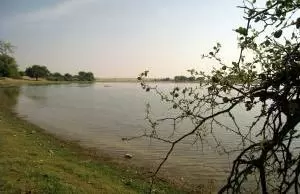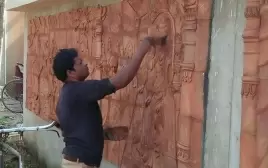Breaking free of the shackles of government aid for basic needs
20-January-2012
Vol 3 | Issue 3
Gahziram’s family has been living at Ekalpaar village of Jaisalmer district for ages but managed to build a pucca house only recently. Besides rearing livestock, he owns 50 bigha of agricultural land which earned him Rs 2 lakh last year.
“Of the savings, Rs 1 lakh was spent on the house. Earlier we barely used to manage food grain for our personal consumption,” he recalls.
 |
|
Several beris like these provide sweet water to villagers of Jaisalmer district (Photos: GOI Monitor)
|
As you stand listening to him, surrounded by the lush green of mustard, gram and taramira, the fact that this area falls in the famous Thar desert seems lost. One pucca house rises after another when you walk down the village. Lot many Ghazirams have belied the geographical connotations of this area.
The neighbouring Dablapaar village reflects similar prosperity. Till five years ago, most villagers used to migrate for work while some of them would end up begging for food in nearby Ramgarh town. Today, the inhabitants have not only become self-sufficient on food and water front, they are also participating much more actively in the affairs of panchayat.
The new found self-respect is an indicator of the success people have tasted in their fields through revival of traditional knowledge related to methodical use of rainwater.
“Our ancestors had been self-dependent in all respects but the younger generation fell into the trap of relying on government for their basic needs. Now self-reliance is again taking roots and in last five years, several villages have prospered,” says Chattar Singh, who has been working with the community to revive traditional water harvesting methods.
The area registers minimum rainfall in the country and irrigation facilities are nil. Still, local communities have devised ways to conserve the rainwater, however less, that nature bestows.
Dropping its common name, khet, a field gets to be called khadin here because it’s cultivated through rainwater collected in a depression. Khadins are developed by building a paal or dorrah (earthen embankment) which helps harvest the water coming from the vast aagaur (catchment area). The impervious layer of bentonite beneath the soil takes up the task from here. If at an optimal depth of 10-15 feet, this layer arrests further seepage of water thus providing sufficient soil moisture for rabi crops to flourish.
Building khadins is a science of working along with nature which the people have perfected through ages. The bow-shaped embankment is built in east-west direction so that the desert wind bellowing from south to north strengthens it with each passing year.
The bow shape divides the force of incoming water preventing any excessive damage to the embankment. This incoming water also carries along with it nutrients from the catchment area thus enriching the soil fertility.
Once the water fills up to an optimal level, the rest is allowed to spill over. The idea is not to forcibly stop water but to humour it so that it stays in the khadin without damaging the wall. “Only 1-1.5 feet of water is needed for a khadin. The surplus is allowed to move on to the next khadin which is how water connects people here. They keep consulting each other on how and when to stop or release the water,” says Singh.
If around 300 small khadins spread over rain fed area of the district help create personal bonds, big khadins like Derasar at Sehua village can be called the pinnacle of community work.
To an inexperienced eye this khadin spread in 500 hectare may seem like an instance of commercial farming but 250 families belonging to three different villages tend this land for several crops.
This spirit of self-reliance also extends to provision of drinking water for both villagers as well as their livestock.
There is no rule but out of traditional wisdom nobody defecates in the catchment. The whole area is cleaned before the arrival of monsoon. In fact, the community welfare is so important that nobody has built a khadin in the catchment area of Biprasar lest it would halt the water flow to the pond.
 |
|
Biprasar pond serves 12 surrounding villages and utmost care is taken to keep it clean
|
The pond is believed to have 120 beris (small wells) of which 24 have been restored. The same impervious layer, which acts as a moisture retainer for khadins, provides sweet water if present 15-50 feet underground. Even if the pond dries up, these beris can serve the population for three years.
It was with this vision in mind that these water sources had been developed years ago. But due to poor maintenance in the recent past they had fallen into disuse.
“Five years ago when the work to restore these beris was started, people of all age groups used to come from surrounding villages and work together. Had these beris been constructed through funding, they would have cost lakhs. But when a community takes such work upon itself, it becomes an easy task done with perfection,” says Farhad Contractor, a social activist, who works on water harvesting systems.
Several villages have now taken upon themselves to restore these valuable water sources. Women of Dablapaar used to walk 12 km to reach Biprasar to fetch water. Today, they have beris within their village which provide them drinking water the whole year round.
Had the locals relied on government, they would have been forced to reconcile themselves with the huge concrete tanks that dot the villages. These tanks, fed by the Indira Gandhi Canal Project through pipes, are supposed to be supplying drinking water.
However, ground realities contradict promises. “Either most of these tanks remain empty or the quality of supplied water is so poor that it is used only for washing. It is not safe to drink this water which is why people prefer beris or talaabs,” says Mohan Singh of Habur village.
Such apparent irregularities in government projects vis a vis perfection in community work has seamlessly led to greater participation of people in governance issues. This was evident in the last panchayat elections when several seasoned leaders lost their support base.
Needless to say people have won the fight for survival. They are now challenging the fiefdoms. - GOI Monitor















